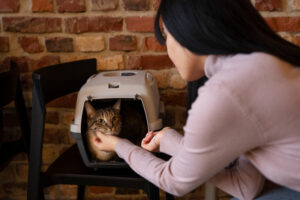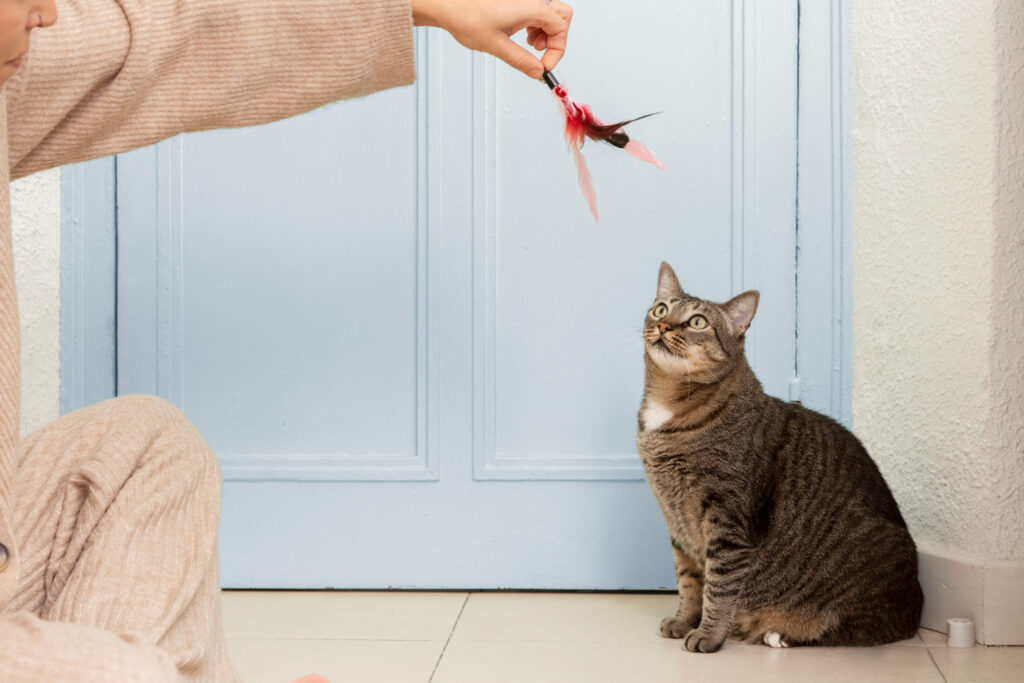Introduction
Train an outdoor cat to stay home can be a challenging yet rewarding task. Whether you’re looking to keep your feline friend safe or simply want to reduce their wandering tendencies, there are several effective strategies you can employ. This guide will walk you through understanding your cat’s behavior, creating a safe and engaging outdoor environment, and using positive reinforcement to encourage them to stay closer to home.
Understanding Your Outdoor Cat
Cats are naturally curious creatures, and their outdoor adventures often satisfy their instinctual needs for exploration and hunting. Understanding these behaviors is the first step in training them to stay home. By recognizing what drives your cat to wander, you can better address their needs and create a more appealing home environment. Outdoor cats may roam due to boredom, hunting instincts, territorial expansion, or the search for mates. Each of these factors can be mitigated by providing appropriate stimuli and care at home, thereby reducing the need for your cat to explore beyond your property.
The Challenges of Training an Outdoor Cat
Train an outdoor cat to stay home involves overcoming their instincts and adapting their routine. This can be particularly difficult if your cat is accustomed to roaming freely. Patience and consistency are key, as is a deep understanding of your cat’s specific behaviors and preferences. Cats are creatures of habit, and sudden changes can lead to stress and resistance. Therefore, a gradual approach, coupled with positive reinforcement, can help your cat adjust to staying closer to home without feeling confined or unhappy.
Why Outdoor Cats Wander
Outdoor cats wander for various reasons, including seeking food, exploring new territories, and mating. Addressing these motivations is crucial in developing a successful training plan. By providing for your cat’s needs at home, you can reduce their desire to wander. For instance, ensuring that your cat is well-fed with regular meals, and providing engaging toys and activities can satisfy their hunting and exploratory instincts. Additionally, spaying or neutering your cat can significantly decrease their urge to roam in search of a mate.
Creating a Safe Outdoor Environment
A safe outdoor environment can help satisfy your cat’s need for exploration while keeping them close to home. There are several ways to achieve this, from building enclosures to creating engaging outdoor spaces. A secure outdoor environment not only keeps your cat safe from traffic, predators, and other dangers but also gives them a controlled space to enjoy the outdoors. This can be done through various methods such as catios, safe fencing solutions, and supervised outdoor time.
Providing Shelter
Cats need a safe place to retreat to when outdoors. Providing shelter, such as a cat house or a cozy spot in the garden, can encourage your cat to stay within your property boundaries. A comfortable and secure shelter can become your cat’s favorite spot, reducing their need to seek refuge elsewhere. This shelter should be weatherproof, comfortable, and located in a quiet part of your yard to offer your cat a sense of security.
Safe Outdoor Enclosures
Outdoor enclosures, or “catios,” offer a secure space for your cat to enjoy the outdoors without the risks associated with free roaming. These structures can be customized to fit your yard and provide plenty of stimulation for your cat. A well-designed catio can include multiple levels, climbing structures, scratching posts, and lounging areas, making it a mini-paradise for your feline friend while keeping them safe from external hazards.
Setting Up a Catio
A catio is an excellent way to offer your cat the best of both worlds—outdoor experience and safety. These enclosed patios can be attached to a window or door, allowing your cat easy access to the outdoors while keeping them secure. Building a catio can be a fun project that not only enhances your cat’s quality of life but also adds value to your property. Ensure the catio is spacious enough for your cat to move around freely and includes various elements to keep them entertained and comfortable.

Fencing Solutions for Outdoor Cats
Fencing can be an effective solution to prevent your cat from wandering. Specially designed cat fences can keep your cat within your yard while still allowing them the freedom to explore. These fences often have a curved or overhanging top that prevents cats from climbing over. Installing such a fence requires some investment and effort but can be a long-term solution to keep your cat safe and close to home.
Training Your Cat to Use an Outdoor Enclosure
Training your cat to use an outdoor enclosure involves positive reinforcement and patience. Encourage your cat to explore the new space by placing treats and toys inside and gradually increasing their time spent in the enclosure. Start by allowing short periods in the enclosure and gradually extend the time as your cat becomes more comfortable. Always supervise initially to ensure your cat feels safe and relaxed in the new environment.
Attracting Your Cat to Stay Home
Attracting your cat to stay home involves making your home and yard more appealing than the unknowns beyond. This can be achieved through positive reinforcement, routine, and engaging activities. The goal is to make your home the most attractive and rewarding place for your cat. Providing regular meals, interactive play sessions, and comfortable resting spots can make your cat prefer staying close to home rather than venturing into potentially dangerous territories.
Using Positive Reinforcement
Positive reinforcement is a powerful tool in training. Reward your cat with treats, affection, and praise when they stay close to home or use their designated outdoor spaces. Cats respond well to positive reinforcement, and consistent rewards can help reinforce the desired behavior. Avoid using punishment as it can lead to fear and anxiety, making your cat more likely to run away.
Creating a Routine
Cats thrive on routine. Establishing a consistent schedule for feeding, playtime, and outdoor access can help your cat feel more secure and less inclined to wander. A predictable routine provides structure and comfort for your cat, reducing their need to seek out new and uncertain experiences. Regularly scheduled activities and meals can anchor your cat’s day, making them more likely to stay close to home.
Establishing Feeding Times
Feeding your cat at regular times each day can help anchor them to home. Consider offering multiple small meals throughout the day to keep them coming back for food. Regular feeding times can create a strong association between home and nourishment, encouraging your cat to stay within the vicinity. If your cat knows that food is reliably available at home, they are less likely to seek it elsewhere.
Offering Engaging Activities
Providing engaging activities and toys can satisfy your cat’s need for stimulation and reduce their desire to explore beyond your property. Interactive toys, puzzle feeders, and regular play sessions can keep your cat entertained and mentally stimulated. Rotating toys and introducing new activities can prevent boredom and keep your cat engaged, making the home a more appealing place to be.
Interactive Toys and Games
Interactive toys and games can keep your cat entertained and mentally stimulated. Toys that mimic prey, such as feather wands and laser pointers, can be particularly effective. Engaging your cat in regular play sessions can satisfy their hunting instincts and provide physical exercise, reducing their need to roam. Interactive toys that dispense treats can also keep your cat occupied and mentally challenged.
Enriching the Indoor Environment
A stimulating indoor environment can make your home more appealing to your cat. This includes providing plenty of climbing structures, scratching posts, and cozy resting spots. Indoor enrichment can satisfy your cat’s instincts and provide a safe and comfortable alternative to outdoor exploration. Creating a dynamic and engaging indoor space can help keep your cat happy and reduce their desire to go outside.
Scratching Posts and Climbing Trees
Scratching posts and climbing trees offer your cat a place to exercise and sharpen their claws. These structures can also serve as safe perches for your cat to observe their surroundings. Cats love vertical space, and providing multiple levels for climbing and perching can make your home more interesting and engaging for them. Scratching posts help keep your cat’s claws healthy and satisfy their natural scratching behavior.
Litter Box Training for Outdoor Cats
Transitioning an outdoor cat to use a litter box can be challenging but is essential for indoor living. Gradually introducing the litter box and using attractants can help. Start by placing the litter box in a quiet, accessible location and encouraging your cat to use it by placing some of their waste inside. Gradually move the litter box indoors if it initially starts outside. Using attractants and positive reinforcement can make the transition smoother.
Transitioning from Outdoors to Indoors
Transitioning your cat from an outdoor to an indoor lifestyle requires patience and gradual changes. Start by increasing their indoor time slowly and creating a comfortable indoor environment. Make sure your home is enriched with toys, scratching posts, and climbing structures to keep your cat entertained. Gradually reduce the amount of time your cat spends outdoors, replacing it with indoor activities and playtime.
Gradual Introduction to Indoor Living
Introduce your cat to indoor living gradually by extending their indoor time each day. Provide plenty of enrichment and comfort to make the transition smoother. Creating a cozy and stimulating indoor environment can make your cat feel more at ease with the change. Patience and positive reinforcement are key during this transition, as sudden changes can cause stress and resistance.
Dealing with Resistance
Resistance is normal when changing your cat’s routine. Address any resistance with patience and positive reinforcement, gradually acclimating your cat to their new lifestyle. Some cats may take longer to adjust than others, and it’s important to be patient and understanding. Using treats, toys, and affection to reward desired behavior can help ease the transition and reduce resistance.
Monitoring Your Cat’s Health
Regular health monitoring is crucial for outdoor cats, as they are more exposed to diseases and parasites. Ensure your cat receives regular vet check-ups and preventive care. Regular veterinary visits can help catch any health issues early and keep your cat healthy and happy. Preventive care, such as vaccinations and parasite control, is essential for cats that spend time outdoors.
Regular Vet Check-ups
Regular vet check-ups can help catch any health issues early and ensure your cat is up-to-date on vaccinations and treatments. These check-ups can identify potential health problems before they become serious and ensure that your cat is in good overall health. Discuss your cat’s lifestyle with your vet to tailor their care to their specific needs.
Preventing and Treating Parasites
Outdoor cats are more susceptible to parasites. Use preventive treatments and regularly check your cat for signs of fleas, ticks, and worms. Regular grooming and parasite control can help keep your cat healthy and comfortable. Consult your vet for the best preventive treatments and regularly inspect your cat for any signs of infestation.
Spaying and Neutering
Spaying or neutering your cat can reduce their urge to roam and contribute to a more settled lifestyle. It also has significant health benefits. Neutering can reduce aggressive behaviors and prevent certain health issues, such as uterine infections and testicular cancer. Additionally, it helps control the population of stray and feral cats.
Handling Behavioral Issues
Behavioral issues, such as aggression or anxiety, can arise when transitioning an outdoor cat to stay home. Address these issues with appropriate strategies and professional help if needed. Understanding the root cause of behavioral problems and addressing them through positive reinforcement, environmental enrichment, and, if necessary, professional guidance can help ensure a smooth transition.
Reducing Stress and Anxiety
Reducing stress and anxiety is essential for a smooth transition. Create a calm environment and use products like pheromone diffusers to help your cat feel secure. Stress and anxiety can manifest in various ways, such as excessive grooming, hiding, or aggression. Providing a quiet, comfortable space and using calming products can help your cat feel more at ease.
Addressing Aggression
Aggression can be a sign of stress or fear. Identify the cause of aggression and use positive reinforcement and gradual desensitization to address it. Providing plenty of enrichment, safe spaces, and positive interactions can help reduce aggressive behavior. If aggression persists, consult with a veterinarian or a cat behaviorist for professional advice.

Socializing an Outdoor Cat
Socializing your outdoor cat with family members and other pets can help them feel more secure and reduce their desire to wander. Gradual introductions and positive reinforcement can help your cat adjust to new social dynamics. Ensuring that your cat feels safe and comfortable around other pets and people can reduce stress and make them more likely to stay close to home.
Ensuring Proper Identification
Proper identification is crucial for outdoor cats in case they do wander. This includes microchipping and using a breakaway collar with ID tags. Proper identification ensures that if your cat does get lost, they can be quickly and safely returned home.
Microchipping Your Cat
Microchipping provides a permanent form of identification. Ensure your contact information is up-to-date in the microchip registry. Microchipping is a simple and safe procedure that can significantly increase the chances of being reunited with your cat if they becomes lost. Always keep your contact details current to ensure the effectiveness of the microchip.
Using a Breakaway Collar
A breakaway collar with ID tags can help return your cat home if they get lost. Ensure the collar is safe and comfortable for your cat to wear. Breakaway collars are designed to snap open if they get caught on something, preventing injury to your cat. Including your contact information on the collar’s ID tag can help anyone who finds your cat reach you quickly.
Engaging the Senses
Engaging your cat’s senses through visual, olfactory, and auditory stimuli can make your home environment more appealing. Providing sensory stimulation can help satisfy your cat’s curiosity and reduce their desire to explore beyond your property. This can be achieved through various means, such as setting up bird feeders outside windows, using catnip and other cat-friendly scents, and playing calming music or nature sounds.
Providing Visual Stimulation
Providing windows with views of the outdoors or setting up bird feeders can offer visual stimulation for your cat. Cats love watching birds and other wildlife, and a well-placed bird feeder can provide hours of entertainment. Window perches or shelves can give your cat a comfortable spot to watch the world outside.
Utilizing Scents and Sounds
Utilizing cat-friendly scents and sounds can make your home more engaging. Use catnip, silvervine, and calming music to create a pleasant environment. Cats have a keen sense of smell, and using scents they enjoy can help make your home more inviting. Calming music or nature sounds can create a soothing atmosphere, reducing stress and promoting relaxation.
Outdoor Cat Safety Tips
Keeping your outdoor cat safe involves being aware of potential dangers and taking steps to mitigate them. This includes avoiding dangerous plants and foods, protecting your cat from predators, and providing a secure environment. Understanding the risks and taking proactive measures can help ensure your cat’s safety and well-being.
Dangerous Plants and Foods
Certain plants and foods can be toxic to cats. Ensure your garden and home are free of these hazards. Common toxic plants include lilies, poinsettias, and azaleas, while foods like chocolate, onions, and garlic can also be harmful. Familiarize yourself with these dangers and ensure your cat’s environment is safe.
Avoiding Predators
Be aware of potential predators in your area and take steps to protect your cat, such as using secure enclosures and supervising outdoor time. Predators can include larger animals like coyotes, birds of prey, and even other aggressive cats. Supervised outdoor time and secure enclosures can help keep your cat safe from these threats.


